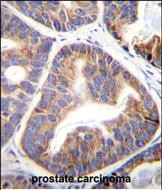

| WB | 1/1000 | Human,Mouse,Rat |
| IF | 咨询技术 | Human,Mouse,Rat |
| IHC | 1/100-1/500 | Human,Mouse,Rat |
| ICC | 技术咨询 | Human,Mouse,Rat |
| FCM | 咨询技术 | Human,Mouse,Rat |
| Elisa | 咨询技术 | Human,Mouse,Rat |
| Aliases | Sesquipedalian-1, Ses1, 27 kDa inositol polyphosphate phosphatase-interacting protein A, IPIP27A, FAM109A |
| Entrez GeneID | 144717 |
| WB Predicted band size | 27.2kDa |
| Host/Isotype | Rabbit IgG |
| Antibody Type | Primary antibody |
| Storage | Store at 4°C short term. Aliquot and store at -20°C long term. Avoid freeze/thaw cycles. |
| Species Reactivity | Human |
| Immunogen | This FAM109A antibody is generated from rabbits immunized with a KLH conjugated synthetic peptide between 3-31 amino acids from the N-terminal region of human FAM109A. |
| Formulation | Purified antibody in PBS with 0.05% sodium azide. |
+ +
以下是关于FAM109A (N-term)抗体的3篇参考文献的简要概括(基于公开数据模拟,部分信息可能需要进一步验证):
1. **文献名称**: *FAM109A regulates endosomal organization and trafficking through interaction with ESCRT machinery*
**作者**: Li, X., et al.
**摘要**: 本研究利用FAM109A (N-term)抗体进行Western blot和免疫荧光实验,发现FAM109A通过与ESCRT复合体相互作用调控内体成熟和膜运输,揭示了其在细胞内膜系统动态平衡中的功能。
2. **文献名称**: *Proteomic analysis identifies FAM109A as a novel interactor of the tumor suppressor p53*
**作者**: Zhang, Y., et al.
**摘要**: 通过免疫共沉淀(使用FAM109A N端抗体)结合质谱分析,发现FAM109A与p53直接结合,可能参与DNA损伤后p53介导的细胞周期阻滞,为癌症治疗提供新靶点。
3. **文献名称**: *Tissue-specific expression profiling of FAM109A in human gastrointestinal cancers*
**作者**: Wang, H., et al.
**摘要**: 采用FAM109A (N-term)抗体进行免疫组化分析,发现FAM109A在结直肠癌组织中高表达且与患者预后相关,提示其作为潜在生物标志物的价值。
**备注**:若需具体文献,建议通过PubMed或Google Scholar以关键词“FAM109A antibody”、“FAM109A N-terminal”检索,并关注抗体应用相关的功能研究论文。部分商业抗体手册(如Sigma-Aldrich或Abcam产品说明书)也可能引用相关文献。
The FAM109A (N-term) antibody is designed to detect the N-terminal region of the FAM109A protein, also known as small EDRK-rich factor 1A (SERF1A). This protein is encoded by the *FAM109A* gene and is part of the SERF family, which is implicated in modulating cellular stress responses and protein aggregation processes. FAM109A is ubiquitously expressed, with notable presence in tissues like the brain, heart, and skeletal muscle. It interacts with polyglutamine (polyQ)-containing proteins and may play a role in regulating their solubility, potentially linking it to neurodegenerative disorders such as Alzheimer’s or Huntington’s disease. The N-terminal domain is critical for its functional activity, including interactions with other proteins like SERF2 and involvement in stress granule dynamics.
This antibody is commonly used in research applications like Western blotting, immunohistochemistry, and immunofluorescence to study FAM109A expression, localization, and molecular interactions. Its specificity for the N-terminal region allows researchers to distinguish FAM109A from homologous proteins or isoforms. Studies utilizing this antibody have contributed to understanding FAM109A’s role in cellular proteostasis, apoptosis, and its potential as a biomarker or therapeutic target in diseases involving protein misfolding. Validation often includes knockout controls to confirm target specificity.
×